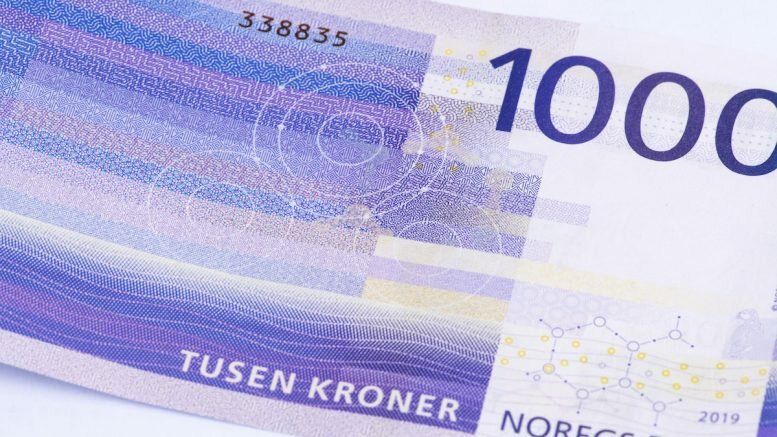The old NOK 1000 banknote is being replaced, and Norges Bank asks the public to exchange or use the old banknotes before the deadline.
A new NOK 1000 banknote was introduced last year, which means that the previous, Edvard Munch-adorned design has had one year to be phased out.
“Useless” NOK 4 billion still in circulation
There are currently 4.3 million old NOK 1,000 banknotes in circulation, that is, more than NOK 4 billion in total.
After November 14, the old banknote (all NOK 4 billion’s worth) will be useless for purchases.
Norges Bank recommends that anyone who still has NOK 1000 banknotes with an old design either use them or deposit them in the bank.
What can I buy for NOK 1000?
For fun, here are a few things you can purchase to get rid of any old NOK 1000 banknotes you have lying around.
- 50 liters of milk
- A two-month gym membership
- 25 cappuccinos at a coffee bar
- 10 nightclub cover charges
- 12 bottles of beer in a bar
- 20 bottles of beer in a grocery shop
Choose wisely.
Old banknotes can still be exchanged for ten years
If you have one of more NOK 1000 banknotes laying around and you just don’t know how to spend them by tomorrow (or if you’re already very well-stocked-up on milk…) – no need to worry.
You can still exchange them for the next ten years, but only Norges Bank is obliged to accept them.
Director of cash payment at the Norwegian central bank, Leif Veggum, says:
“If you do not use the old notes, they can be exchanged free of charge at Norges Bank for ten years after they expired. In other words, the old banknotes have not lost their value even though they no longer circulate as a means of payment.”
You can exchange the banknotes into a Norges Bank deposit account directly, or send them to the central bank by post to have them deposited in an account.
Some banks can still accept the banknotes, but as previously mentioned, only Norges Bank is obliged to do so. This also applies to any other expired banknotes, of which there are still many in circulation.
A big change for Norwegian change
Not only has the NOK 1000 banknote been redesigned, the entire NOK banknote series has been replaced in recent years.
Instead of Edvard Munch’s likeness, the new NOK 1000 note carries motifs from the sea, with open water on the back and a wave on the front.
“Our impression is that the new banknote series has been very well received, both among the public, the press and in the design community”, says Veggum.
Increased security is the reason why the banknote series has now been replaced.
Veggum explains, “In recent years, many of the countries around us have issued new and safer banknotes. Banknote counterfeiting is fortunately uncommon in Norway. But there’s still a risk.”
Iridescent design elements; a puffin as a watermark; a chain that looks as if it’s moving when you tilt the banknote back and forth; and microscript are among the new security measures that will ensure safe identification and a higher threshold for counterfeiting.
At the same time, the new banknote series is the first to break the tradition of having portraits of famous Norwegians on the banknotes.
Cash use is decreasing in Norway
Norwegians are increasingly paying by card rather than cash.
From 2017 to 2018, the share of cash withdrawals at ATMs fell by 13%, and from 2018 to 2019, withdrawals fell by a further 14.1%.
Cash payments in connection with in-store purchases have also decreased. Payments fell by 16.1% from 2018 to 2019, according to Norges Bank.
This year, the use of cash has continued to decreased significantly due to the corona.
“In recent years, cash payments have accounted for just under 10% of payments in situations where it is possible to pay in cash. But in the last two surveys, which were conducted after the corona measures were implemented, the proportion is down a further 3-4%”, says Veggum.
He continues, “It must be assumed that this is related to the fact that many stores have asked their customers to pay in other ways, and some refuse to accept cash.”
How big is the need for cash in Norway today?
“Cash is the only alternative to bank account money for most people, and it forms an important part of the infrastructure in the payment system.
“Cash supports trust in bank account money, it ensures competition between means of payment, and it have some characteristics that bank account money does not have.
“One of these characteristics is that cash can be used independently of third parties or electronic systems. This means that cash forms a central part of emergency preparedness should electronic systems fail”, Veggum points out.
NOK 1000 banknotes have been seen less frequently in recent years. Why is that?
Veggum explains, “It is difficult for us to speculate. The banks themselves choose which denominations they use, for example in ATMs.
“In general, high denominations are used more often for safekeeping than lower denominations.”
© NTB Scanpix / #Norway Today





Leave a comment